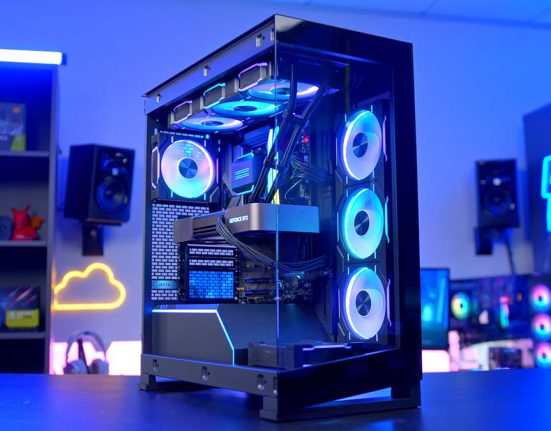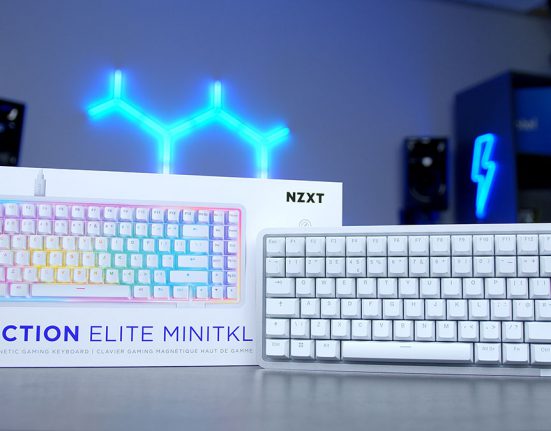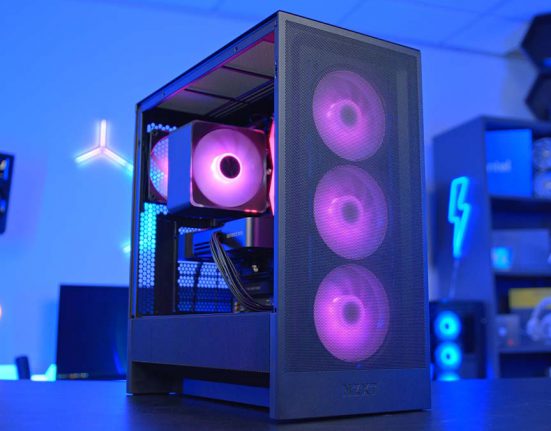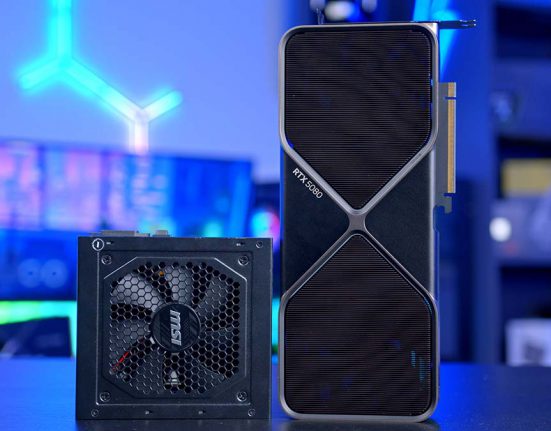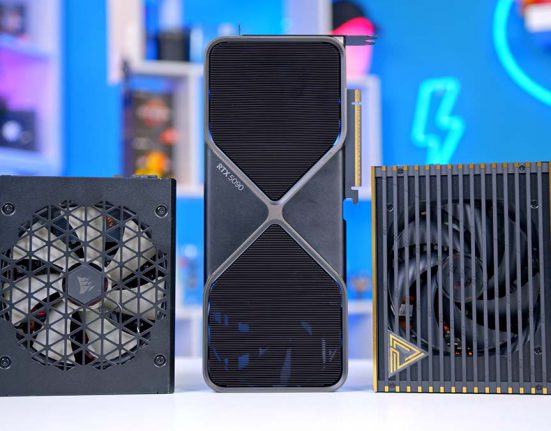The H7 Flow (2024) is the second revision of the original H7 Flow released mid-2022. This revised design improves internal case space for better cooling support and room for bigger motherboards. It also brings better ventilation and uses a different rear chamber layout to provide more clearance at the front of the case while minimising hindrances to the cable management room. We’ve tested the NZXT H7 Flow (2024) in a series of builds and benchmarks to see how it compares to its older versions.
NZXT has always been a popular manufacturer for their cases, and the H7 range demonstrated their willingness to get with the times and provide a chassis that offered solid functionality and aesthetics. However, the main point of comparison to draw in this review is how this 2024 version of the H7 Flow compares to other solid cases released in the same year. NZXT has a significant amount of competition to beat, and considering the standard H7 Flow is priced around $130, this case needs to bring some heat to the table to beat out options like the Montech King 95 Pro, Fractal Design North, Lian Li O11 Vision and more.
As per all of our PC case reviews, we’ll examine this chassis key specs and compare them to the 2023 and 2022 versions. We’ll also explore its design, building quality, and features to determine its value proposition.
Buy the NZXT H7 Flow (2024) on:
Specification
The NZXT H7 Flow 2024 edition is a tall mid-tower ATX case. It utilises a traditional box layout, with the front panel supporting fans and radiators instead of being glass, contrasting with the vast number of fish tank cases released over the past year. The benefit of this layout is that airflow and ventilation are generally much more substantial. Air can be taken in from the front and exhausted from the rear. Only one glass panel blocks air from escaping, which helps with thermals.
Because this case is slightly bigger than its previous iterations in height and width, there’s more space for motherboards and room for a 420mm radiator at the front. While the 2023 and 2022 iterations were restricted to supporting up to ATX boards, the H7 Flow 2024 has enough clearance for E-ATX boards, providing more build configurations for prospective buyers.

While motherboard clearance has improved, the space for graphics cards and CPU coolers has remained unchanged. The H7 Flow (2024) can accommodate graphics cards up to 410mm long and CPU coolers up to 185mm tall, which are the same specs as the older versions. It’s worth noting that the number of PCI-E slots has remained the same, at 7, and the front IO has not changed either.
Cooling support is where things start to differ slightly. Because of the redesign of the PSU chamber, there’s considerable space at the bottom of the case for fans or an additional radiator. Where the 2023 and 2022 H7 Flow cases could only support a maximum of seven fans, the 2024 iteration adds another three, a significant improvement. This doubles as space for a 360mm AIO (all-in-one) liquid cooler. Some manufacturers will only provide enough space for extra fans, but space for an extra radiator opens up options for custom cooling configurations.
| Specification | NZXT H7 Flow (2024) |
|---|---|
| Form Factor | Mid-Tower |
| Motherboard Support | Mini-ITX, Micro-ATX, ATX, E-ATX |
| Case Dimensions (L x W x H) | 468mm x 244mm x 544mm |
| Front IO | 2 x USB 3.2 Gen1 Type-A 1 x USB 3.2 Gen2 Type-C 1 x 3.5mm Combo Jack |
| PCI-E Slots | 7 |
| Colour | Black White |
| Max Clearance | 185mm Cooler Height 410mm GPU Length 200mm PSU Length |
| Drive Support | Up to 4 x 2.5 inch Up to 2 x 3.5 inch |
| Fan Support | Front: 3 x 140mm Top: 3 x 120mm Rear: 1 x 140mm Bottom: 3 x 120mm |
| Radiator Support | Front: Up to 420mm Top: Up to 360mm Rear: Up to 120mm Bottom: Up to 360mm |
| Pre-Installed Fans | 3 x 120mm |
| MSRP | H7 Flow (2024): $129.99 H7 Flow RGB (2024): $149.99 |
Regarding pricing, I think both models of the H7 Flow are more expensive than they should be. If we look at the specs alone, they’re pretty standard for an ATX case. It only comes with three pre-installed fans and offers a decent amount of space for various builds. But there’s nothing here that stands out to me as mindblowing, so the $130-$150 MSRP feels a bit steep. I know we harp on the Montech King 95 Pro, but this is the kind of case you should be getting for $150, which is tough competition for the H7 Flow (2024).
NZXT H7 Flow (2024) Design
It isn’t often that I get to review a relatively standard ATX mid-tower case. While I appreciate that the market is constantly changing, the number of dual-chamber fish tank cases we’ve seen has become increasingly dull. It’s nice to see NZXT sticking to their roots with a more traditional-looking case that doesn’t overcomplicate things.
Like its siblings from previous years, the H7 Flow (2024) is a heavily perforated chassis with a tempered glass side panel. The original H7 Flow was a first for NZXT in terms of providing improved airflow, so it’s great to see this design continue to offer plenty of ventilation. The front panel is a metal mesh backed by a dust filter to minimise blockage.

Removing the tool-less tempered glass panel on the side exposes the internals, of which there is plenty of internal space due to the lack of a PSU shroud. The rest of the panels around the case are also tool-less and can be quickly removed for easy access to the mounting rails.
From an aesthetic point of view, the H7 Flow (2024) is a simple-looking case. Nothing is outstanding stylistically, but it looks and feels premium. The metal used to construct the case feels robust and sturdy with minimal flexing. The colouring is consistent across the metal. We’ve opted for the black version, so other dark components will blend in nicely.

One area that I’m not a massive fan of is the raised feet design. Instead of using four individual feet, NZXT has opted for a seamless raised design, where the feet at the front and back are aligned with their respective panels rather than offset. Quite frankly, it just looks odd. Some prospective buyers may appreciate the design change, but it doesn’t appeal to me, and I would prefer a standard set of case feet.

Moving around to the back of the case, this is where most of the internal design changes have occurred. A small amount of space has been carved out for the power supply, placing it at the bottom of the chassis. However, it’s only visible from the back of the case. This is a nice touch because it reduces the visible cable mess, but cable management will be tighter.

The rear of the case has a couple of extra features worth noting. A thumbscrew holds in a removable drive mounting panel. Taking this out will expose the back of the motherboard but can also improve cable clearance.
Additionally, the left side of the case has Velcro ties to keep wires at bay. The signature cable management bar has also persisted on the H7 Flow (2024), which provides a large cutout for cables to thread through.

The IO on the NZXT H7 Flow (2024) is also parallel with the side panel instead of sitting horizontally across the front panel. The type and number of IO ports haven’t changed between models, but its repositioning will make it more accessible in some setups.

Building in the NZXT H7 Flow (2024)
On paper, the NZXT H7 Flow (2024) is pretty similar to its previous iterations, but it offers some solid design changes that make it worth considering. However, building a PC with it is the easiest way to gauge its quality. We paired up with NZXT H7 Flow (2024) with the MSI MAG X670E TOMAHAWK WiFi motherboard, an RTX 4080 SUPER graphics card, and a whole host of other excellent components to determine the pros and cons of this case.
Internal Space
The 2024 H7 Flow feels much more spacious than its previous versions. Because it lacks a power supply shroud, there’s ample room to move your hands around, so clearance across the board will be solid.
Getting the motherboard installed was nice and easy. As this is an ATX case, the H7 Flow is pre-configured to support ATX boards straight out of the box, so there’s no reason to move any standoffs. The board slipped into the case with no hassle and was easily screwed down using the motherboard screws found in the accessories box. The standoff at the centre of the case was also raised, so installing the board while the case was upright was quite simple.

Securing the graphics card was the next task after installing all the fans and the cooler. For this build, we opted for the NVIDIA RTX 4080 SUPER Founders Edition. This card has a black design, which fits in nicely with the build’s colour theme. Again, getting this card installed was relatively hassle-free. There’s 410mm of space for long GPUs, which is 106mm of additional space beyond the length of the card.

The case offers reusable PCI-E covers, which is great to see. We’ve recently used some cases with cheap single-use covers, which is inexcusable for modern cases. Unfortunately, the H7 Flow doesn’t have a GPU support bracket, but the 4080 SUPER felt secure once it was fastened down.

Radiator and Fan Mounting
Support for cooling is one of the critical strengths of the H7 Flow (2024), which has improved upon its previous iterations by providing more space. The main change is that the front panel now supports 420mm radiators (or three 140mm fans). The bottom panel also has space for an additional 360mm radiator (or three 120mm fans) due to the location of the PSU shroud.

In this configuration, we shifted the fans around and added some extras to improve airflow. James noted that he wasn’t a fan of the single 360mm unit at the front of the case, primarily because it would make more sense to have a 420mm set of fans here instead. For this reason, we removed the 360mm unified set of fans from the front and placed it on the bottom.

It’s worth highlighting that fans or a radiator are screwed in through the bottom of the case, and there are some rubber grommets that the screws thread through.

The front panel features a removable mounting bracket, like the 2023 version of the H7 Flow, making installing or removing parts easy. At the front, we grabbed some NZXT F140 RGB Core fans and installed them here. This makes the case look more fleshed out, reducing the amount of space and gaps between the bottom and top of the front panel.

At the top, we installed a Kraken Elite 360 AIO, securing an F360 RGB Core unit to the radiator instead of the fans that come with the cooler as they’re not RGB. The top panel is entirely tool-less, so this was removed to expose the mounting rails.

We also added another F140 RGB Core to the back of the case as an exhaust fan to keep the system nice and cool. Once all of these were installed, the case looked much more fleshed out. Getting all the extra fans secured was straightforward, but there’s nothing particularly noteworthy from a features point of view.

Ease of Building
Overall, the NZXT H7 Flow (2024) was easy to build with. If NZXT has kept anything consistent, building with their cases offers a solid experience. Pretty much all of the panelling is tool-less, which makes removal and assembly straightforward.
The design is clean and sturdy. The PSU’s vertical installation at the back of the case allows for considerable clearance, opening up more options for cooling and airflow configurations.
At the back of the case are two distinct zones for cable management. These zones include Velcro ties to secure everything down, which is a nice touch.
Features We Like
Tool-Less Panelling
The NZXT H7 Flow (2024) is designed to make building a PC easy, and one way that NZXT has done this is by offering a primarily tool-less case. The front, sides and top panels aren’t held in by any screws and can quickly be taken off the chassis with a firm pull. Each panel features a push-pin mechanism to secure them, which makes accessing the internals of the H7 Flow quick and straightforward.

More Cooling Space
Features-wise, the jump between the 2022 and 2023 models wasn’t huge. There were a few feature changes, but both cases are pretty similar. However, the changes to the 2024 variant of the H7 Flow are significant. Cooling support is incredibly strong, and the additional space for a 420mm AIO at the front and three 120mm fans at the bottom drastically increases airflow and thermal capabilities.

Features We Don’t Like
360mm Unit on the Front Panel
Placing a 360mm unit on the front panel makes little sense. While we understand that this might have been to save on costs, the H7 Flow (2024) supports a 420mm cooler and 140mm fans, so we would have much preferred these over 120mm fans. It won’t be a deal-breaker for some because including fans is great to see. But the amount of open space left by the 360mm unit doesn’t look great.

Conclusion
NZXT H7 Flow (2024)
Product Name: H7 Flow (2024)
Brand: NZXT
-
Features
-
Design
-
Versatility
-
Value For Money
Summary
The NZXT H7 Flow (2024) is a well-built case. While it offers similar features compared to its previous variants, some solid design changes bring better support for radiator and fans, a revised area for cable management, and generally more space across the board. Like most NZXT cases, the H7 Flow (2024) offers a minimalist but sophisticated aesthetic while catering well to first-time and novice builders thanks to its primarily tool-less set of panels.
The more significant issue with the H7 Flow (2024) is pricing. The RGB model is around $150, which aligns it with highly competitive chassis like the Montech King 95 Pro or more unique offerings like the Cougar FV270. If the H7 Flow were priced lower, its value proposition would be much stronger. But at this price point, it’s challenging to recommend above the competition when the alternatives can offer definitively better features or design qualities. If you’re willing to swallow the price, the NZXT H7 Flow (2024) is a solid offering, but we recommend looking at other similarly priced cases before you make your decision.
Pros
✅ More fan/radiator space
✅ Easy to build in
✅ Solid cable management
Cons
❌ Lacks 140mm pre-installed fans
❌ Strange feet design
❌ Similar to previous designs



![FI_[DM76] HAVN BF360 5090 Build](https://geekawhat.com/wp-content/uploads/2025/10/FI_DM76-HAVN-BF360-5090-Build-1-551x431.jpg)
